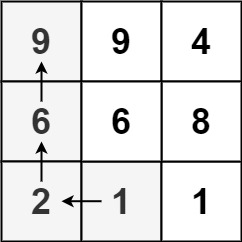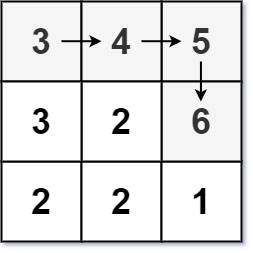Given an m x n integers matrix, return the length of the longest increasing path in matrix.
From each cell, you can either move in four directions: left, right, up, or down. You may not move diagonally or move outside the boundary (i.e., wrap-around is not allowed).
Example 1:
Input: matrix = [[9,9,4],[6,6,8],[2,1,1]]
Output: 4
Explanation: The longest increasing path is [1, 2, 6, 9].
Example 2:
Input: matrix = [[3,4,5],[3,2,6],[2,2,1]]
Output: 4
Explanation: The longest increasing path is [3, 4, 5, 6]. Moving diagonally is not allowed.
Example 3:
Input: matrix = [[1]] Output: 1
m == matrix.lengthn == matrix[i].length1 <= m, n <= 2000 <= matrix[i][j] <= 231 - 1
class Solution:
def longestIncreasingPath(self, matrix: List[List[int]]) -> int:
if not matrix or not matrix[0]:
return 0
m, n = len(matrix), len(matrix[0])
memo = [[0] * n for _ in range(m)]
def dfs(i, j):
# If already computed, return the stored value
if memo[i][j] != 0:
return memo[i][j]
# Possible moves: right, left, down, up
directions = [(0, 1), (1, 0), (0, -1), (-1, 0)]
max_length = 1
for di, dj in directions:
ni, nj = i + di, j + dj
if 0 <= ni < m and 0 <= nj < n and matrix[ni][nj] > matrix[i][j]:
max_length = max(max_length, 1 + dfs(ni, nj))
memo[i][j] = max_length
return max_length
longest_path = 0
for i in range(m):
for j in range(n):
if memo[i][j] == 0:
longest_path = max(longest_path, dfs(i, j))
return longest_pathO(m×n). In the worst case, the DFS for each cell is only computed once thanks to memoization. Each cell effectively participates in DFS exactly once.
O(m×n) due to the space used by the recursion stack (in the worst case, the path could be as long as m×n cells) and the memoization table.

